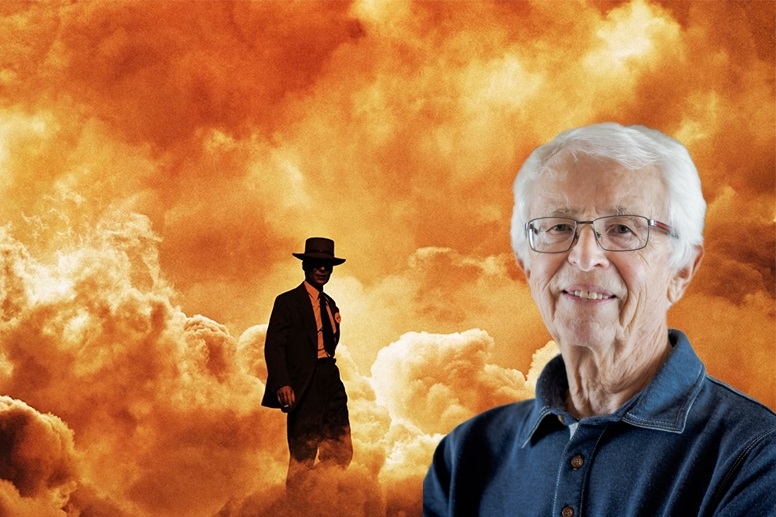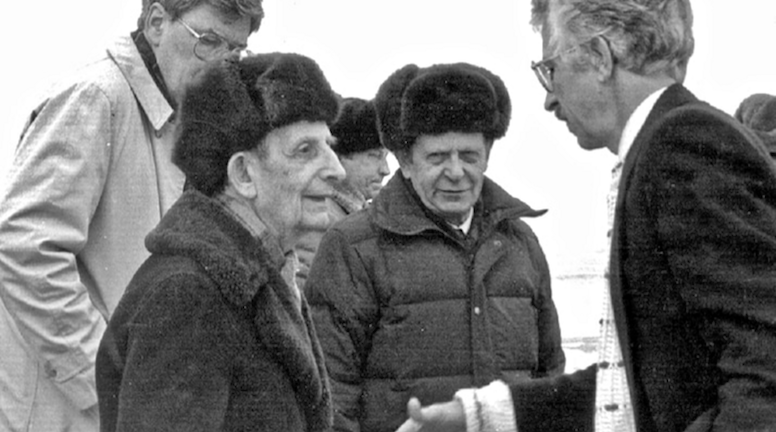Deep Cuts: The Ultimate Oppenheimer Reading List from Our Nuclear and Security Experts
| by Sierra Abukins
Just saw the Oppenheimer film and hungry for more? Our global security faculty and researchers have recommendations.

“The science was good enough. There’s a lot more behind the questions the film raises on how scientists should work with the military. The film succeeded in making you think.”
Siegfried (Sig) Hecker, the fifth director of the Los Alamos Laboratory, recently shared his reaction to the new film, Oppenheimer, during a far-ranging conversation with undergraduate nonproliferation fellows studying in Monterey this summer. Hecker joined the students by videoconference from his home in New Mexico. Hecker is a distinguished professor of the practice with the James Martin Center for Nonproliferation Studies, the largest nongovernmental organization in the United States devoted exclusively to research and training on nonproliferation issues. The following includes excerpts from that conversation with framing questions and expanded comments.
What is your connection to Oppenheimer and the events in the film?
I walked in Oppenheimer’s footsteps, but I could never fill his shoes. I served as director of Los Alamos Laboratory from 1986 to 1997, a very different time. What we did share was that neither of us was the obvious choice for the position. He had no administrative experience. I was also a practicing scientist and I’d say I had the same lack of administrative qualifications.
Do you agree with director Christopher Nolan’s opinion that Oppenheimer was “the most important man who ever lived?”
I give him a lot of credit. I never met him, but I met most of the other characters portrayed in the movie. Oppenheimer was able to accomplish what he did because he was the most respected theoretical physicist in the U.S. at the time. Most of them were in Europe. They were all either Oppenheimer’s colleagues or students. He was a centerpiece who was able to attract those key people to the Manhattan Project.
History has shown that what he was able to do was simply incredible—the combination of intellect and his ability to manage people. He was able to get along with foreign scientific dignitaries. Some others could have done it, but I think he was the best choice. I wouldn’t make him the most important individual of the 20th century though.
A theme throughout the film is the role of scientists. In one scene Oppenheimer is wearing a military uniform and tells another scientist that they’re all required to enlist in the U.S. Army. His colleagues tell him to refuse and that scientists should always be independent civilians.
What they never mentioned is that the way they solved the problem wasn’t for Oppenheimer just to take off the uniform. They enlisted the University of California to run the laboratory, including procurement and personnel. [General Leslie] Groves wrote Oppenheimer a letter about how the University of California would run the lab and the military would run the town. The letter helped Oppenheimer recruit key scientists like Robert Bacher, who along with Isidor Rabi told him they would never work for the military. The original agreement was that the lab would go back to military control once they came close to the bomb, but Groves thought it was working fine and let it be. The Los Alamos Laboratory was operated by the University of California until 2005, when the government, in its infinite wisdom, decided it wouldn’t give an automatic extension. That’s when I left to go to Stanford University.
Is the science accurate in Oppenheimer?
The way the science was portrayed was fine—no great mistakes. It has to be publicly understandable and Nolan did a good enough job. When you have scientists talking about explosive lenses, that’s really tough for the general audience to be able to sort out! Nolan took a few liberties with people and events, but I think it was within the range of artistic license.
As a metallurgist who has studied plutonium since the mid-1960s, I think they could have made plutonium more scientifically interesting—it is the most complex element in the periodic table. Uranium acts like many metals, but plutonium is like nothing else. As Oppenheimer pointed out many years later, plutonium is not a warm and fuzzy material. It doesn’t stay still. It’s the most complex thing. When they took it from Los Alamos down to Trinity, they had this grapefruit-sized core. At Los Alamos, it was cast and pressed before being nickel plated. One of the hemispheres developed a blister in the coating. The project’s chief metallurgist, Cyril Stanley Smith, developed a last-minute fix by inserting gold foil around the blisters. That was incredible. That scene would have added a little more drama to the preparations for the Trinity test.
Do you have any critique of the film?
I have read several critiques that complain that not enough was shown of the human tragedies inflicted by the bombings in Japan, and nothing was said about the damaging effects of the radioactive cloud unleashed by the Trinity test. From my perspective, I would have liked to have the film also reflect on more than the bad side of things nuclear—the weapons, risk, and nuclear contamination. There’s also a good side. I don’t want a “nuclear-free” world. I want more nuclear power because we’re heating up our planet and we need to do everything we can do before that becomes an existential threat. Your kids and grandkids are going to look back and say, “What were they thinking? How could they not build more nuclear power plants for green power to reduce global climate change?”
Because of the factor of millions in energy released in nuclear reactions compared to chemical reactions, the good things about nuclear energy are really great and the bad things are horrendously dangerous. The point is that one has to manage that process to get the most from the benefits of nuclear energy and avoid the worst. You have to manage to get the best out of the atom. Oppenheimer focused primarily on the risks—particularly to avoid an arms race with the Soviet Union. He dismissed nuclear energy right after the Manhattan Project, stating that it was not what was needed at that time.
Dwight D. Eisenhower was briefed on Oppenheimer’s comments about needing to manage the risks associated with the arms race before he gave his Atoms for Peace speech to the UN General Assembly on December 8, 1953. Eisenhower said, “I want to give people some hope.” His speech is incredible.
You must weigh the good with the bad and that’s the message that is lost. That’s the part we should also stress. You can make up your own mind on what’s most important to you.
Will the Oppenheimer film have a positive or negative impact in advancing a nuclear-weapons-free world?
The action that I had hoped this movie would bring about is for people to think deeply about these nuclear matters. I think Nolan has done that. He makes us think—many of us.
In the last 30 years, I’ve given some 500 public lectures, taught many students, and written two books on things nuclear, and maybe I’ve reached 25,000 people. In two weekends, Christopher Nolan has already reached maybe 20 million people and might reach 100 million people to think about nuclear things—that’s impact.
You have to manage to get the best out of the atom.
One critique of the film is that it is very America-centric and doesn’t convey the devastating human toll of dropping the bomb on people in Hiroshima and Nagasaki. What do you think?
On the 50th anniversary of the bombing in 1995, I was director of the Los Alamos National Laboratory. I wrote an article called Reflections on Hiroshima and Nagasaki for the lab’s internal newsletter, The Inside Story. I asked, “Was it necessary? Was it the right thing to do?” My answer was that I didn’t know. I said that I cannot today put myself back into the shoes of what it was like at the time that the decision was made.
The more important question for me at that time was “Did we learn from it?” Particularly that we should never again use nuclear weapons.
I faced the personal qualms of morality. I didn’t go to Los Alamos to work on nuclear weapons. I went because it was one of the best scientific laboratories in the whole wide world. Of course, as director, I had to deal with the fact that we built nuclear weapons.
I remember that when I joined as a student in 1965, then director Norris Bradbury told us newcomers at orientation, “We don’t build nuclear weapons to kill people. We build weapons for the leaders of the world to buy time to find other ways to settle our differences.”
As for being America-centric, one can look at how and why other countries have acquired nuclear weapons and how they think about them. I have been in all countries that have declared nuclear arsenals. Let me touch on Russia and comment on the Russian Oppenheimer—what was he like? What were they thinking when they built the bomb? How would they now think about using the bomb when they’ve never done so?
I met the Russian Oppenheimer—VNIIEF Scientific Director Yuli Khariton—in Sarov (the Russian Los Alamos). He welcomed me with a friendly handshake in February 1992 and explained the origins of the Soviet nuclear program. He was a much less conflicted person than Oppenheimer. There were no internal arguments about building and testing the bomb (on August 29, 1949) because the Americans had already done so. They have not faced the moral qualms about using the bomb since they haven’t. Yet, even in the Soviet Union, scientists such as Andre Sakharov, the father of the Soviet hydrogen bomb, spoke out against atmospheric nuclear testing because of the dangers of radioactive contamination.
Every other nuclear country has had to make its own decisions on whether or not to build the bomb. So far, none have decided to use it in war.

We’re in a very different world now than the one depicted in the film. How can this film still speak to people living today?
The fact that nuclear weapons have not been used—what some call the nuclear taboo—since 1945 is remarkable. Yet, as Nolan reminds us at the end of the film, the dangers are clearly still with us.
The biggest concern today is Russia and its unprovoked and brutal invasion of Ukraine. With the end of the Cold War, it looked as if we got over the threat of nuclear use and annihilation. With President Putin threatening the use of nuclear weapons in Ukraine, we are back at the brink. We’ll need you, the next generation, to keep the world safe.
| by Sierra Abukins
Just saw the Oppenheimer film and hungry for more? Our global security faculty and researchers have recommendations.
Nuclear nonproliferation researcher Masako Toki writes in the Bulletin for the Atomic Scientists that the dwindling number of atomic bomb survivors—known as hibakusha—have an important role for teaching the next generation of nonproliferation experts.
| by Sierra Abukins
The Institute’s scientist-in-residence, Ferenc Dalnoki-Veress, is part of a small team of global experts who are calling on Japan to look at other options for the contaminated water.